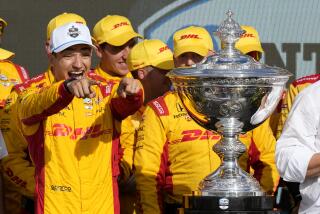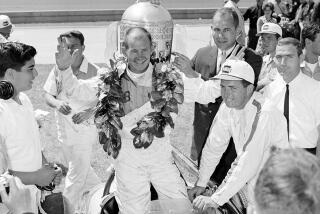Stunning Finish at Daytona : Auto racing: When a cut tire flattens Earnhardt, unheralded Derrike Cope comes away with first victory.
DAYTONA BEACH, Fla. — First Buster Douglas, now Derrike Cope.
In another stunning upset, the unheralded Cope knocked out Dale Earnhardt to win the Daytona 500 Sunday before a shocked crowd of 150,000 stock car fans.
Or rather, it was a cut tire less than a mile from the end of the 500-mile race at Daytona International Speedway that knocked out Earnhardt, and Cope was there to take advantage of the situation.
Seldom had any car dominated a race the way Earnhardt’s Chevrolet Lumina did, leading 155 of the 200 laps and pulling more than half a lap ahead late on the sunny day.
“We had a tire go right in front of the chicken-bone grandstands on the back stretch,” said the disconsolate loser. “I was just sitting there, they couldn’t catch me.
“Derrike wins the race, but we beat them all day. They didn’t outrun us, they just lucked into it.”
When Earnhardt swung high on the banking going into the third turn heading for what would have been his first Daytona 500 win, it was apparent that his car was in serious trouble.
Cope, right on his bumper, had to jerk his car to the left to avoid the slowing car, and then had to beat Terry Labonte, Bill Elliott and Ricky Rudd in a trophy dash to the finish line.
“I just turned that baby left as hard as I could and said, ‘Stick, baby,’ ” Cope said. “I never turned a car as hard as that before. It was really amazing because I’d kept telling myself to keep cool and hold on to second place.
“Labonte was making it tough for me, making my car loose by getting up close, but all I had in mind was hanging on to Dale and having him pull me along.”
Cope was so unprepared for the way the race ended that he did not know where to go to Victory Lane.
“I had no idea where it was,” he said. “I figured I’d keep on driving down pit row until I saw my crew. I figured they’d find it before me.”
Earnhardt slipped all the way back to fifth place before he limped home with a badly mangled right rear tire.
“I hit some debris, I don’t know what,” Earnhardt added. “I heard it hit the bottom of the car and then it hit the tire. That’s when it popped. There ain’t nothing you can do about something like that.”
The debris turned out to be a piece of bell housing that later ended up in Rudd’s radiator, where crew chief Waddell Wilson found it after the race.
Although his Purolator Chevrolet ran close to the leaders all day, the 32-year-old Cope was a most unlikely beneficiary of Earnhardt’s misfortune.
He had never won a Winston Cup race in 71 starts, had never finished better than 27th before in the Daytona 500, had never finished better than sixth in his NASCAR career and last year had only four top-10 finishes.
The $188,150 he won Sunday far exceeded the $125,630 he won in 23 races last year. His highest previous single-race purse was $16,775 for a sixth place at Charlotte.
And he is the first driver from the Winston West series to win at Daytona, or any other NASCAR track other than Riverside International Raceway.
Cope, who is from Spanaway, Wash., began racing in late model sportsman cars on the West Coast in 1980 after a knee injury cut short his baseball career as a catcher for Whitman College.
He drove first for his father, Donald, who raced top fuel and top gas dragsters in San Diego before moving the Cope family to Washington when Derrike was four. In November of 1982, Cope made his Winston West debut with longtime West Coast driver George Jefferson as his car owner. His first race was in the Winston Western 500 at Riverside, driving an ’82 Ford that failed to finish.
He was voted rookie of the year in 1984 and missed winning the championship by only four points behind Jim Robinson of North Hollywood.
In 1986 Cope decided to move to Charlotte, N.C., and challenge the big boys.
After several uneventful years, he joined car owner Bob Whitcomb, a New England businessman, midway through last season and with veteran Buddy Parrott as crew chief, the team began to show improvement. Parrott, who was crew chief for Richard Petty when he won his 200th race in 1984 at Daytona, says Cope reminds him of a young Darrell Waltrip, with whom he worked in 1977.
“We made some changes this year, like switching from a Pontiac to a Chevrolet and getting our engines from Hendrick Motorsports,” Parrott said. “When we tested well over the winter, we were looking forward to winning a race or two this season. But not the Daytona 500!”
Cope is the fourth driver to make stock car racing’s premier race his first win. The others are Tiny Lund in 1963, Mario Andretti in 1967 and Pete Hamilton in 1970.
Before Earnhardt’s surprising exit from the lead, the race had been a ho-hum affair where the cars were strung out around the 2 1/2-mile track most of the day behind the black No. 3 Chevrolet that showed no signs of weakness.
When Geoff Bodine spun in the second turn on lap 193, Earnhardt elected to pit for four tires and a splash of fuel. Cope did not stop and took the lead, but when the green flag came out with five laps remaining, Earnhardt wasted little time in returning to the lead.
For four laps, Earnhardt never looked back as Cope, Labonte and Elliott followed single file--until the loose bell housing ripped open his tire.
“I can’t believe it happened,” Earnhardt said. “This is the biggest buildup and biggest letdown I’ve ever had in racing. There’s nothing you can do about it, though. You can’t kick the car and cry and pout and lay down and squall and ball.
“You’ve got to take it and move on. We just ran a quarter of a lap short on luck today.”
It was the second late-race heartbreak for the three-time Winston Cup champion. In 1986 he appeared to have the race won after leading for 34 laps when he ran out of gas three laps from the finish and had to watch as Geoff Bodine cruised past to the checkered flag.
Unlike the wrecks that made Daytona look like a junk yard the past week, Sunday’s race was remarkably clean. Only three minor accidents, which brought out the caution flag for 15 laps, slowed the pace, enabling Cope to average 165.761 m.p.h. for the race.
The first caution came when Richard Petty spun into the infield on lap 27, killing hopes for Petty fans that stock car racing’s No. 1 idol might regain some of his lost luster. Petty later returned and limped around, 17 laps behind the leaders, to finish 34th.
Another legendary character, A.J. Foyt, dropped out with dizziness after finishing 115 laps.
“I got so dizzy I couldn’t see,” Foyt said. “The problem was with my helmet and uniform. The fumes of the glue in the helmet got me drunk. I thought I better park it before I hurt myself or someone else. I don’t know how anybody can take drugs and drive. I never had anything like this ever happen to me before.”
Two movie cars, shooting scenes for the Tom Cruise film, “Days of Thunder,” kept pace with the field for 100 miles and then retired, as planned, without incident.
Ken Schrader, who started at the rear of the 42-car field after crashing his pole-sitting Chevrolet during one of the Twin 125 qualifying races last Thursday, provided most of the excitement early in the race. Schrader picked off cars by the bunches, moving all the way up to second behind Earnhardt, in 24 laps.
Twice, after slow pit work by his crew, Schrader again was forced to move from 15th up to second again and then from 16th to third before he slowed on the backstretch with a blown engine on the 58th lap.
More to Read
Go beyond the scoreboard
Get the latest on L.A.'s teams in the daily Sports Report newsletter.
You may occasionally receive promotional content from the Los Angeles Times.










